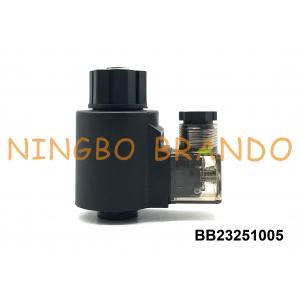

Add to Cart
φ23mm AC220V Solenoid Hydraulic Coil For Yuken DSG Series Hydraulic Directional Valve
This φ23mm x 46.7mm x 51mm hydraulic solneoid coil is applied in Yuken DSG Series Hydraulic Directional Valves. Hydraulic solenoid valves are components used in hydraulic transmissions to control fluid pressure, flow, and direction. The pressure control valve is called a pressure control valve, the flow control valve is called a flow control valve, and the directional control valve is called to control the on, off and flow directions. The directional control valve is divided into a one-way valve and a reversing valve according to the purpose. The one-way valve only allows the fluid to be unidirectionally connected in the pipeline, and the reverse direction is cut off. Directional valve: change the on-off relationship between different pipelines, according to the working position of the valve core in the valve body, two, three, etc.; according to the number of channels controlled, two-way, three-way, four-way, Five-way, etc.; according to the spool drive mode, manual, motorized, electric, hydraulic, etc.
Technical parameter of DSG Yuken Type Hydraulic Directional Valve Coils:
| Model number | BB23251005 |
| Normal voltage | DC12V / DC24V (±10%) |
| Normal power | DC:28W, DC:38W |
| Material | Plastic, Brass |
| Wire class | H, F |
| Connection | DIN 43650A |
| Application | Yuken DSG Series Hydraulic Directional Valve |
| Hole diameter | 23 mm |
| Height | 51 mm |
| Width | 46.7 mm |
Main dimension of Yuken DSG Series Directional Control Valve Hydraulic Coil:
DIN43650A Connection Hydraulic Coil For Yuken DSG Series Directional Valve:
Applied in Yuken Type DSG Series Hydraulic Directional Control Valve:
More details about Hydraulic Coil For Yuken DSG Series Hydraulic Directional Valve in below Youtube Video:
Classification of hydraulic solenoid valve with electromagnetic coil:
Hydraulic solenoid valves are components used in hydraulic transmissions to control fluid pressure, flow, and direction. The pressure control valve is called a pressure control valve, the flow control valve is called a flow control valve, and the directional control valve is called to control the on, off and flow directions.
1. Pressure control valves are divided into relief valves, pressure
reducing valves and sequence valves according to their purposes.
(1) Overflow valve: It can control the hydraulic system to maintain
a constant state when the set pressure is reached. The relief valve
for overload protection is called a safety valve. When the system
fails and the pressure rises to a limit that may cause damage, the
valve port will open and overflow to ensure the safety of the
system.
(2) Pressure reducing valve: It can control the branch circuit to
obtain a stable pressure lower than the main circuit oil pressure.
The pressure reducing valve can be divided into fixed value
pressure reducing valve (output pressure is constant value),
differential pressure reducing valve (input and output pressure
difference is fixed value) and proportional pressure reducing valve
according to the pressure function controlled by it. (Proportion is
maintained between input and output pressure).
(3) Sequence valve: After an actuator (such as a hydraulic
cylinder, a hydraulic motor, etc.) can be actuated, the other
actuators are operated in sequence. The pressure generated by the
oil pump first pushes the hydraulic cylinder 1 to move, and at the
same time, the oil inlet of the sequence valve acts on the area A.
When the hydraulic cylinder 1 is completely moved, the pressure
rises, and the upward thrust acting on the area A is greater than
the setting of the spring. After the value, the spool rises to make
the oil inlet and the oil outlet communicate, so that the hydraulic
cylinder 2 moves.
2. The flow control valve adjusts the flow rate by adjusting the
throttle port area between the spool and the valve body and the
local resistance generated by the valve body, thereby controlling
the moving speed of the actuator. Flow control valves are divided
into five types according to their purposes. (1) Throttle valve (2)
Speed control valve (3) Diverter valve (4) Collector valve (5)
Split flow collecting valve
3. Directional control valves are divided into one-way valves and
reversing valves according to their purposes.
(1) Check valve: Only the fluid is allowed to be unidirectionally
connected in the pipe, and the reverse direction is cut off.
(2) Reversing valve: change the on-off relationship between
different pipelines, according to the working position of the valve
core in the valve body, two digits, three digits, etc.; according
to the number of channels controlled, two-way, three-way, Four-way,
five-way, etc.; according to the spool drive mode, manual,
motorized, electric, hydraulic, etc.
Welcome to your any question and inquiry!
